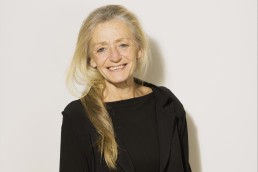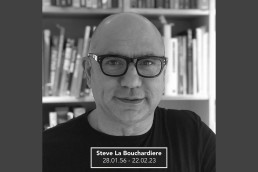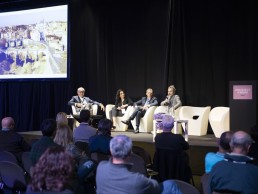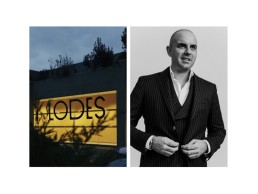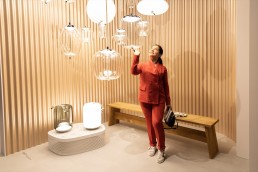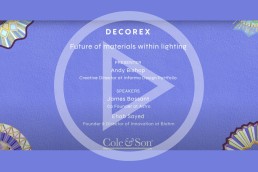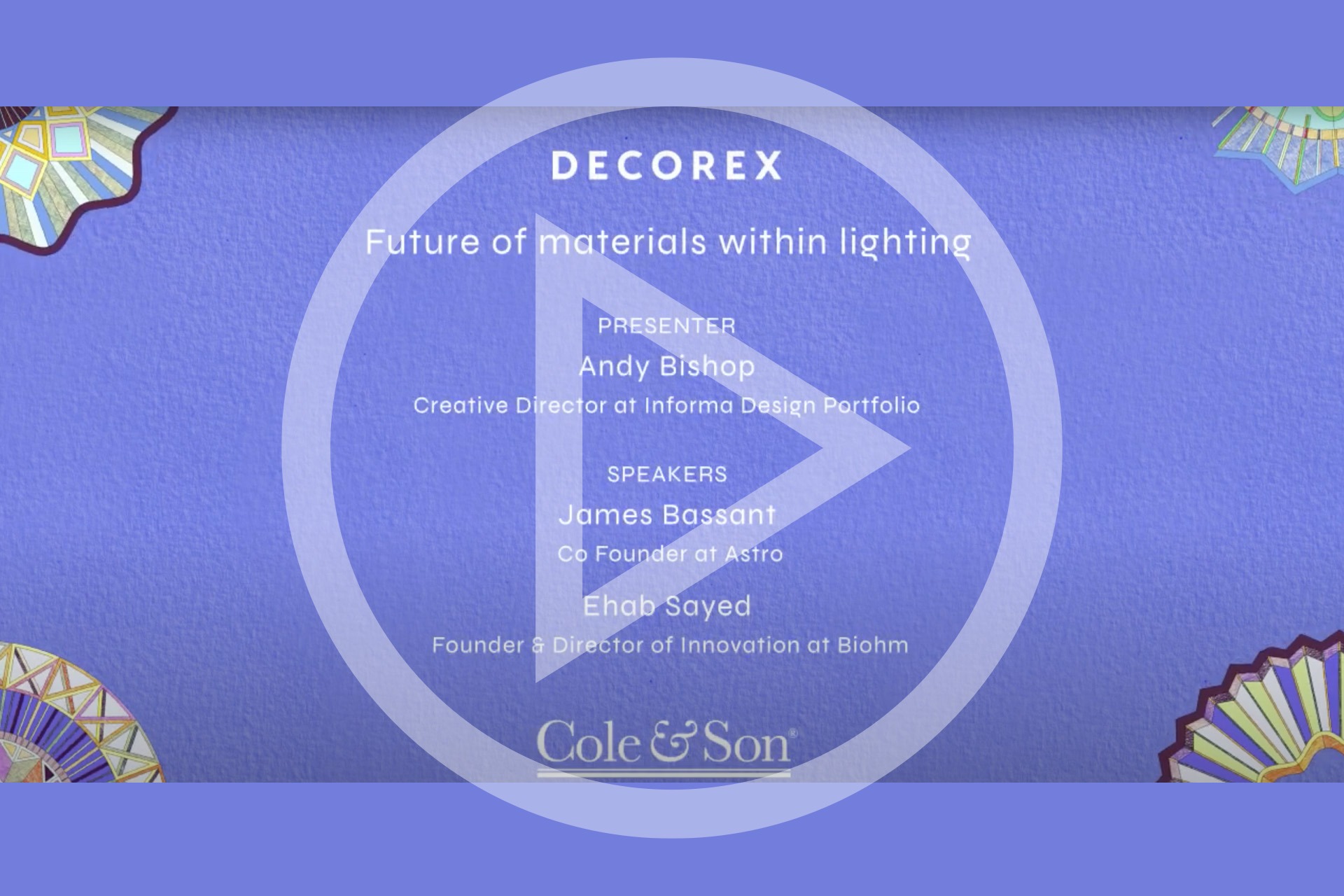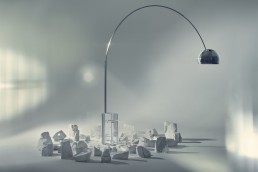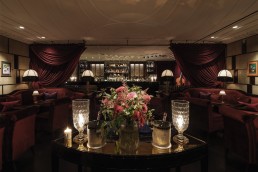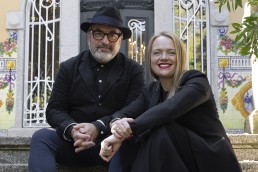Co-founder and Vice-president of Santa & Cole Nina Masò dies
(Spain) - Interior designer and Editor, Co-founder and Vice-president of Santa & Cole, Nina Masò dies aged 66.
In 1982 Masò met the designer Gabriel Ordeig Cole. Together they began a personal and professional relationship, carrying out various lighting and interior design projects for emblematic Barcelona bars and nightclubs such as Boliche, El Café del Sol, Cibeles, the Al Dente restaurant and the Sísísí bar.
In 1983, Masó opened the Paspoc shop in Cardedeu where she offered her personal selection of interior design products and gifts. In 1985, together with Javier Nieto Santa and Cole, they founded Santa & Cole, design editions. This was a new concept in Spain at the time, applying publishing to the field of industrial design, and seeking to promote a warm light that was not typical for the time.
Since 1985, Masó was the editor at Santa & Cole, and the soul of the company. She designed all the showrooms and stands for the main international trade fairs in the sector. She collaborated with Cole in the creation of the Sleeping Beauty lamp, a revolutionary proposal that coloured fluorescence.
Masó was an ambassador for the idea of warm and welcoming light, "a friendly light because good light makes you better. It's about making people look beautiful in the light". Her vocation led her to travel around Spain and abroad defending this light in a travelling presentation inspired by García Lorca's La Barraca, which she made her own. Masó led other projects as an interior designer, including the Embassy of Local Democracy in Sarajevo, promoted by Barcelona City Council in 1996, the Telefónica Corporate University in La Roca (Barcelona) in 2007 and the Casa Bonay hotel in Barcelona. Her last major project was the restoration of the building that houses the headquarters of Santa & Cole, in Parc de Belloch (Barcelona). Her hallmark as an editor was based on a sensitive and warm look at the environment where objects are the protagonists.
Nina Masò, Barcelona, 14 April 1956 – 27 February 2023.
www.santacole.com
Design LSM Co-Founder Steve La Bouchardiere dies
(UK) - Co-Founder of DesignLSM Steve La Bouchardiere has passed away aged 67.
Brighton-based multi-disciplinary studio DesignLSM was co-founded by La Bouchardiere and Simon McCarthy in 1988. The studio is best known for its high-profile hospitality designs, creating strategy, branding, architecture and interior design services for this sector.
Over the last 36 years, the studio has grown around its co-founders' enthused passion for creating inspiring hospitality spaces. Embarking on the role of Managing Director since Steve stepped down, Holly Hallam has driven and built up the studio’s strategy service, bringing her considerable experience to the industry, and creating unique consumer engagement strategies for DesignLSM’s clients.
McCarthy says of his friend's passing: "It’s with complete sadness that I have to let everyone know that my great friend and business partner for over 35 years, Steve, sadly and suddenly passed away Wednesday afternoon after losing his battle with cancer. Words are too difficult to describe how sorely missed his massive personality will have on me.
"I thank him for being a great friend and a strong advisor to me and many of our team and clients through the years he steered DesignLSM. We send our love to Becky and the family. May he rest in loving peace."
Holly Hallam, Managing Director and Rachel Pratt, Studio Director, add: "The DesignLSM team, especially Rachel and I, are indebted to Steve for the many years he spent building and driving forward DesignLSM successfully. His experience and knowledge of the industry was vast, which he generously shared with us all. Steve had a unique ability through his humour, kindness and wit to make everyone feel at ease in any situation. Through his infectious passion, enthusiasm and fondness for the hospitality industry, he made many great friends and memories with the clients and suppliers he encountered.
"Rachel and I will always be grateful for the opportunities and skills he provided us, and our team, with and we intend to honour his legacy through the future of DesignLSM. His vibrant, kind and fun-loving spirit will be missed by us all."
Howard Brandston, lighting design pioneer, dies aged 87
(USA) – Howard Brandston, founding member of the IALD and pioneer of the lighting design profession, has passed away at the age of 87.
Born in Canada, Brandston moved to the United States at the age of 9, growing up in New York. From an early age, Brandston had a passion for theatre and art that was encouraged by one of his early mentors – his art teacher at Lincoln High School in Brooklyn, Leon Freund.
Speaking to arc in 2008, he said: “Leon had been involved in the government-sponsored WPA projects of the Depression. He called us his ‘Art Squad’; in art studio, he would say to the class ‘You have a blank piece of paper in front of you: it represents an opportunity to create a work of art. Let’s see what you can do.’”
Brandston’s interest in the arts eventually led to him studying Theatrical Illumination at Brooklyn College. Following his studies, Brandston worked as an assistant to lighting luminary Stanley McCandless, whom he credited as being a major influence and inspiration on both his work and his design philosophy.
Following the overriding ethos of “Rules are a substitute for thinking, and I wasn’t going to stop thinking,” Brandston branched out from theatre lighting into architectural lighting design, initially alongside McCandless, before taking a job with architectural lighting designer Seymour Evans, whom Brandston described as “a character beyond belief”.
From here, Branston established his own lighting practice, Howard Brandston Lighting Design Inc – now known as Brandston Partnership Inc (BPI) – in 1965. Through this, one of Brandston’s first major projects was the Canada Pavilion at Montreal Expo in 1967; this in turn led to an opportunity to work on the American Pavilion at Expo 1970 in Osaka, Japan.
In the following 50 years, BPI has completed more than 5,000 projects around the world and has expanded from its New York headquarters to offices in Shanghai, Beijing, Shenzhen, Chengdu, Singapore and Seoul.
Notable projects from Brandston’s illustrious portfolio include the restoration of the Statue of Liberty; the Detroit City lighting masterplan; the Petronas Twin Towers in Kuala Lumpur (formerly the tallest building in the world); the American Museum of Natural History, New York; and the Marina Bay Financial Centre in Singapore.
Alongside his stellar work with BPI, Brandston was also passionate about teaching – he led a design studio at Rensselaer Polytechnic Institute (RPI), and was actively involved in the Lighting Research Institute, The Lighting Research Center at RPI, and the Lighting Research and Education Fund. In 1981, he also founded the Annual Workshop for Teachers of Lighting and endowed the annual Brandston Student Lighting Competition as part of the awards programmes of the Illuminating Engineering Society of North America (IESNA).
Brandston was also one of the founding members of the International Association of Lighting Designers (IALD), establishing the association in 1969. Speaking to online lighting platform Lytei, he recalled its formation: “We were setting the standard; we were all looking for excellence; we all had the same goal, even if we didn’t have the same methods; we were all heading in the same direction, even if it was by a different path.”
Across his career, Brandston received many lighting awards, including the Lifetime Achievement award with the IESNA and IALD; Fellow status with the IALD; Honorary Fellow of the Chartered Institution of Building Services Engineers (CIBSE); Honor Award for Contributions to Architecture from the American Institute of Architects (AIA); and he has been inducted into the Interior Design Hall of Fame.
Longtime business partner Robert Prouse, who retired from BPI in 2018, announced the news of Brandston’s passing on LinkedIn. He said: “It is my sad duty to tell you that Howard Brandston passed away peacefully this afternoon, after a few days in hospice care. For those that didn’t know him, he was a towering figure in architectural lighting design. He was a founding member of the IALD, Past President of the IESNA, and recipient of many awards.”
Speaking of Brandston’s legacy, IALD President Mônica Luz Lobo, said: “Words can’t express the contribution he made to our profession. To refer to Howard as an icon in the lighting design profession only begins to touch upon his impact and importance. He is warmly remembered and revered, and the IALD community worldwide owes him immense thanks for his talent, care, and contribution over a lifetime of fantastic achievement.”
Considered by many to be one of the founding fathers of modern architectural lighting design, Brandston leaves behind a rich legacy and will be long remembered for his invaluable contributions to the lighting design profession.
“Light is everywhere. Light is everything. Light is life. It is art, it is science, it is whatever you wish to make it.” – Howard Brandston, 1935 – 2023
Watch a six-part interview series with Brandston, filmed by Lytei in 2020, here.
darc to host Defining the Circularity of Light talk at Workspace Design Show
(UK) - The Workspace Design Show returns to London’s Business Design Centre, on 27-28 February 2023.
The show brings together a thought-provoking programme of talks featuring a whole host of speakers, from developers to architects and their blue-chip clients, along with accomplished exhibitors showcasing the latest workplace interiors innovations. All of the content aligns with the show’s theme, Destination Workplace: Places Where People Want To Be.
The four talks programmes that attendees can choose from are the Workspace Design Talks, bringing you insights on workplace strategy and design; FIS Conference, offering the latest from the finishes and interiors sector; The Occupiers Forum: The View from HQ, providing the perspectives from the all-important occupiers; and Sustainability Works, addressing the latest challenges in sustainability and ESG in our workplaces. Over 100 speakers will be debating these issues from companies such as tp bennett, American Express, Heatherwick Studio, Grimshaw, PLP Architecture, Jacobs, Unilever, PwC, Nokia, Legal & General, DWP and CBRE.
Defining the Circularity of Light will be hosted by darc's editor Sarah Cullen. She will be joined by expert panellists Kael Gillam, Principal Lighting Designer at Hoare Lea; Faye Robinson, Founder of lighting design practice Treacle Studio; Tom Niven, Associate in Lighting at BDP; and Tulin Kori, Associate Partner at Foster + Partners.
The talk will look at discussing the various roles and responsibilities held by the key players in a new project, and encouraging clients, contractors and designers that circularity is beneficial for all involved.
Visitors can listen to the scheduled talks with leading architects, designers and occupiers talking about the latest trends, challenges and innovations within this year's 'Design Talks Lounge’. This has been curated by international furniture specialists, The Furniture Practice, in collaboration with multidisciplinary studio, Acrylicize. The Lounge will host the Workspace Design Talks across the two-day event, where leading voices at, Perkins+Will, Foster & Partners, WeWork and more will debate the current themes shaping today's work environments. The space will incorporate furniture by several iconic brands including Andreu World, Arper, Fredericia, Moroso and Vitra; while the stage will feature an immersive installation, designed by Acrylicize, celebrating material innovation in furniture and interior design with materials by Foresso, Kvadrat, Kvadrat Really and Autex. Flooring for the space will be provided by Tarkett.
Registration to attend is free and can be completed here: https://registration.gesevent.com/survey/29napt742208g
Architect@Work returns this March
(UK) - Architect@Work, the two-day trade fair aimed at the British architecture and design (A&D) community, will return to the Truman Brewery, London on 22 and 23 March.
The 10th edition will see a line-up of talks and over 200 of the latest product innovations in surface solutions, lighting technology, as well as interior and exterior fixtures and fittings, showcased by a selection of leading architectural suppliers. Other show highlights include the RIBA Bookshop and a photographic exhibition by World-Architects. With a free bar and catering throughout, visitors will be able to network in a modern, creative and lounge-like atmosphere.
This year’s theme, Energy & Ecosystems, will allow the talks programme to explore a range of different projects, places and experiences. Talks will take place both in-person and via live stream.
The keynote talk in the series will be with Amin Taha. After working for a number of architectural practices such as Chris Wilkinson Architects (later Wilkinson Eyre) and Zaha Hadid Architects, he founded Amin Taha Architects in 2003 in London that later changed its name to Groupwork. Author Dr Ruth Lang will be in conversation with Taha about the journey to a future built on the past.
For the first time, Architect@Work will host a Negroni Talk. Created in 2018, The Negroni Talks – hosted by architects Fourthspace and sponsored by Campari – were set up to replicate the lively and provocative debates that took place in the European café culture of the early twentieth century. This lively debate series has taken the architecture scene by storm, picking up an Archiboo Award in 2021 and spawning a host of articles and wider industry conversations.
'Net zero – fact or fallacy?' will question what the concept of net zero really means. With carbon offsetting taking place abroad, there is a fiery debate raging about the ethical and practical implications of net zero.
'Positive about energy saving' will explore how the energy our buildings consume (or operational carbon to the initiated) is one of the big challenges architects, designers and developers face. Tenants want to work in a green building and new regulations are shifting towards more efficient places to live and work in. How do we manage this from the concept and financing, through to the landscape and lighting?
'Making the most of waste' will question how we fit out our homes and workspaces with materials that make the most of waste and whether this affects aesthetics. Chaired by Debika Ray, editor of Crafts Magazine.
'Earth Building: what can the planet provide?', chaired by curator and writer Vanessa Norwood, will explore how we create a new built environment using the materials supplied by Mother Earth. Ancient buildings were made of straw, timber and stone. It looks like a brighter and more sustainable path might be trodden if we return to our roots but we will need research and clever engineering.
'Creating climate equity' will discuss how the key to making better environments for all is through inclusivity and diversity. We can create spaces that work better for different communities by listening to a broader spectrum of opinions.
Lodes announce expansion into North America
(USA) - Italian lighting brand Lodes announces its expansion into the North American market with a dedicated U.S. subsidiary and office.
A significant milestone for the Venice-based, family-owned and operated manufacturer, this key moment marks a new chapter in the brand’s 70-plus-year history, furthering its international expansion and strengthening its presence in the States. The announcement comes from a year of exponential growth, high-profile collaborations, and technological innovations.
From the opening of its Milan showroom in the heart of the Brera district to the continued partnership with brand Diesel Living, and new and ongoing collaborations with renowned designers and firms such as Snøhetta, Patrick Norguet, Nika Zupanc, and Studio YOY—2022 was a pivotal year. Lodes' more significant North American presence builds on that momentum, increasing brand awareness and enabling the company to more directly meet its US and Canadian clients' unique needs. In addition to its commercial/hospitality business, this local headquarters will also create opportunities to grow its retail/residential presence and enhance its e-commerce visibility.
“I am incredibly proud of the growth we've been able to achieve since my grandfather, Angelo Tosetto, founded the company in 1950,” comments Lodes Managing Director, Massimiliano Tosetto. “Lodes currently conducts business in 90 countries. Our further expansion into the NA market underscores the company’s commitment to offering contemporary design solutions that celebrate our Italian DNA and manufacturing know-how to our growing commercial and residential client base. I am thrilled that this long-standing plan has come to fruition and excited for what the future will bring as we continue on an upward trajectory.”
Josie Anthony, Co-Founder of Lodes’ former distributor JB Lighting Collection, will play a key role in the establishment of the U.S. branch. A longtime contributor to Lodes’ success in the market, Anthony will continue to work closely with Lodes leadership in Italy and will remain the principal point of contact of Lodes USA, serving as the brand’s Managing Director. Eva Luliano, also formerly of JB Lighting Collection, will join Anthony in continuing to provide support in her new role as Operations Manager. Lodes USA is based in the New York Metropolitan area with service throughout North America and is sold through a network of trusted distribution partners across the continent.
Euroluce is back and so are we...
Milan Design Week and more importantly, Euroluce are back!
April in Milan is a key date for anyone in the design and specification market looking for the very best the industry has to offer; and with the added bonus of Euroluce making it's long-awaited return, darc magazine couldn't be happier to head back to the Italian city.
As in previous years, darc magazine will be the ONLY resource designers and specifiers need for the latest lighting launches, announcements, and collaborations coming out of Milan in April; whether that's at the Fair, the Archiproducts showroom, or one of the bustling Design Districts - if you're planning to visit, watch this space for our extensive coverage!
Make sure you’re featured!
Are you exhibiting at Euroluce? Planning an event in Milan centre? Presenting an installation? Hosting a party?
Make sure darc's Editor, Sarah Cullen know's about your plans ASAP! As we move closer to the date, her diary is going to start filling up quickly and she needs to be at your event to capture that all important social media post to share with our thousands of followers. Email her with your press announcements, party invites and events (including any embargo details) on: s.cullen@mondiale.co.uk
As in previous years, the Mar/Apr issue of darc will be distributed from the Archiproducts showroom and the Euroluce Fair for the entire week. Get your brand in front of thousands of specifiers by booking an advert in this all-important issue. As a thank you for supporting the magazine, you will be able to take advantage of our dedicated editorial coverage, which includes a Printed Event Guide in the Mar/Apr issue of the magazine + dedicated Newsletter sent to our 12,000+ digital subscribers the opening morning of the Fair.
Don't fancy an advert? For just £300, you can still guarantee your editorial inclusion by booking an Enhanced Listing in the Milan Guide + dedicated Newsletter - shining a light on your product launch, party, or installation.
 Above: Example of an enhanced listing in the Milan Guide.
Above: Example of an enhanced listing in the Milan Guide.
For more information on all of the above, please contact Helen Ankers at h.ankers@mondiale.co.uk or Stephen Quiligotti on +44 7742 019213
The darc team is so excited to be back in one of the most beautiful design capitals of the world! We can't wait to see what everyone has in store for us…
The Future of Materials in Lighting - Decorex 2022
Decorex invited darc magazine to host a talk at its 2022 show in London, UK. Unfortunately due to Covid, darc magazine’s editor Sarah Cullen was unable to host the discussion. Andy Bishop, Creative Director of Informa, kindly stepped in to moderate the discussion between James Bassant, Co-owner and Design Director of British lighting brand Astro, and Ehab Sayed, Founder and Director of Innovations at Biohm. The discussion revolved around the topic of materials and their usages in lighting product design and manufacturing in the future, as well as what’s being taken into consideration when specifying these future-proof products in projects. Ideas covered included sustainability, product longevity, environmental impact, and industry trends.
Paint Vs. Light
Interior designer and BIID member Sam Bird, of Trindade & Bird, shares insight into the design considerations when working with paint colours and textures and light in residential projects.
When it comes to choosing colour for your walls, the next most important thing to consider is light.
A common misconception about a space and its lighting is that the smaller the room, the lighter the colours must be in order to make it feel bigger and brighter. When in fact, the opposite is true. Take a basement, for example, that has minimal to no daylight exposure. The best thing to do is to lean into its natural cosiness and choose dark colours and rich textures to create the ultimate intimate space. More on this later…
But first things first, what needs to be established is the client’s desire for a space. When beginning a new project, it is key to understand what they want out of it, as well as how they are intending to use it. That way, you will naturally tailor your scheme to suit their requests, and begin the process of understanding how colour, texture and furniture are going to fit in situ.
It’s important to understand how the use of colour, lighting and the impacts of daylight levels will affect the use of the room. The architectural layout of a property and its physical positioning (south-facing for example), are also key to understanding how the interior interacts with the architecture and how that balances with the levels of natural light the property receives.
An example of this can be seen in the location of my previous home. It wasn’t the biggest house in the world and we were set in the woods surrounded by lots of trees. So, even though daylight would come through the windows, during the summer it was never a bright house because of the constant canopy of surrounding trees. It was in fact a very dark house. And so we ran with that and used a lot of dark colours - we actually painted the whole house in one colour - and created a melting effect, which we then piled a load of textures into.
We like to use the term “melting effect” to describe where we blend the same colour across the whole room, from skirting boards to the ceiling, to create the idea that the colour is melting into the whole space and blending the room altogether.
If you’re trying to make a room feel bigger, you need to look at how it is laid out to maximise space as much as you can. The idea of not using colour and going all-white in a smaller space to make it feel bigger is a misconception of what’s really going to happen with that space. It’s all about the size of the furniture and how you place it to make that space feel right. Funnily enough, for a small space you should actually go bigger with the furniture and aim for less clutter.
Choosing the correct paint is your next step. A few years ago, we used to regularly use a matte paint that had added marble to it, which created a unique reflective texture to the finish. Nowadays, we stick fast to a completely flat, matte finish, because it can create some interesting shadows and contrasts that you can use to your advantage in a scheme. We stay away from anything that has too much sheen. Generally what we often do is bring those colours across the entire room, as mentioned before in the melting effect. This allows for an interesting contrast between both the ceiling and walls, and even though it is the same paint and colour, various shadows and tones are reflected at various points of the day.
When it comes to selecting paint colours and textures, it is essential to be mindful of the quality of the brand you are working with. As with many things in life, you pay for what you get regarding a product’s quality, and much is the same when it comes to paint.
The way light interacts with your paint choice will depend entirely on its quality, and not necessarily its colour. If you are using paint that has a lot of sheen to it, it’s going to cause chaos with the lighting. If you stay with the higher-end brands, you’re not going to have the same issues of uncontrollable light reflections or light absorptions.
Light temperatures, lux levels and overall quality of lamps are extremely important as well; you have to be really careful with your light source choice. When completing a project, we ensure to leave one of each type of light source with our client for any inevitable replacements to make sure the correct quality lamp is used.
A lot of how the lighting interacts with the room’s colours comes down to the programming too. For instance, if you are using reds in a room and rich-toned velvet, you will experience a lot of light and colour changes. Velvet has a lot of reflective qualities to it, but when brushed by hand in another direction, it fills with dark tones. Once you put light onto that fabric, you can exacerbate those effects.
Colour and light spill from decorative fixtures is another aspect to consider in a space. If you have spent a lot of care on a particular wall finish and colour that you do not want to be disrupted by coloured light spill from a decorative shade, for example, there are things you can do to minimise this. Taking shades as an example further, there are things you can use such as a blackout lining. This allows the light to flow directionally upwards and downwards, but it does not spill through the fabric of the shade. This works in favour of both the wall treatment behind the lamp, as well as for the fabric or finish of the shade itself not losing its impact through backlighting. It allows you to be really selective with your light output. Alternatively, you can use an opaque lining that does allow for light to dissipate through the shade and create an overall soft illumination. This is the most typical finish for a shade, however, the blackout linings create a unique aesthetic that allows for the shade to stand out as a piece of art on its own. If you are using a colour scheme much the same as our melt effect that runs the colour across the entire room, wall lamp shades are something that needs careful consideration if you are matching them to the wall colour, as an opaque lining illumination will change its colour completely.
Undertones of paints can vastly change how a colour is perceived during the day and night. For a recent residential project, Hollandbury Park, I used a dark blue colour in a bedroom that had really dark green undertones. The room was designed with nighttime in mind, as a space that is used mostly in times of darkness. The way the colour changed throughout different times of day was drastic, and again with the bedside lamps during the evening and early morning. The colour temperature of your electric lighting against paint colours with cooler or warmer undertones is also worth considering, as it will impact the overall feel of the space during hours of darkness.
Timeless Design
Flos releases an iconic Castiglione design with an updated, sophisticated material to celebrate its 60th anniversary.
In 1962, designers Achille and Pier Giacomo Castiglione created the iconic Arco floor lamp, the same year design brand Flos was established. Synonymous with Italian design, the lamp became one of the most well-recognised, imitated and referenced pieces of Italian design. Sixty years later, Flos celebrates the lamp’s anniversary with the release of a limited edition lead-free crystal base.
The original design took inspiration from street lights - a simple structure that allows directional light without the construction limitations of installing a chandelier. A telescopic, satin-finished stainless steel arch allowed light to be diffused through a height-adjustable reflector finished in pressed, polished aluminium and protected with a clear varnish. A 60kg white Carrara marble base anchored the structure, and a dimmer switch allowed for light intensity adjustability.
At first glance, a small hole in the base appears to be a contemporary design feature. However, it has a practical purpose as an access point for a broom handle, or something similar, to aid in lifting and transporting the lamp and its heavy base.
To celebrate the lamp’s 40th anniversary, Flos released a limited edition Arco with a black marble base. And again, for its 50th anniversary, the brand paid tribute to the piece, releasing it in an LED version.
Arco K, the most recent limited edition version for the lamp's 60th anniversary, sees its base transformed into a material the team deemed more appropriate to the duo’s original design intentions. The aim was for the base to draw the viewer’s gaze from the arch to its origin and structure that supports it.
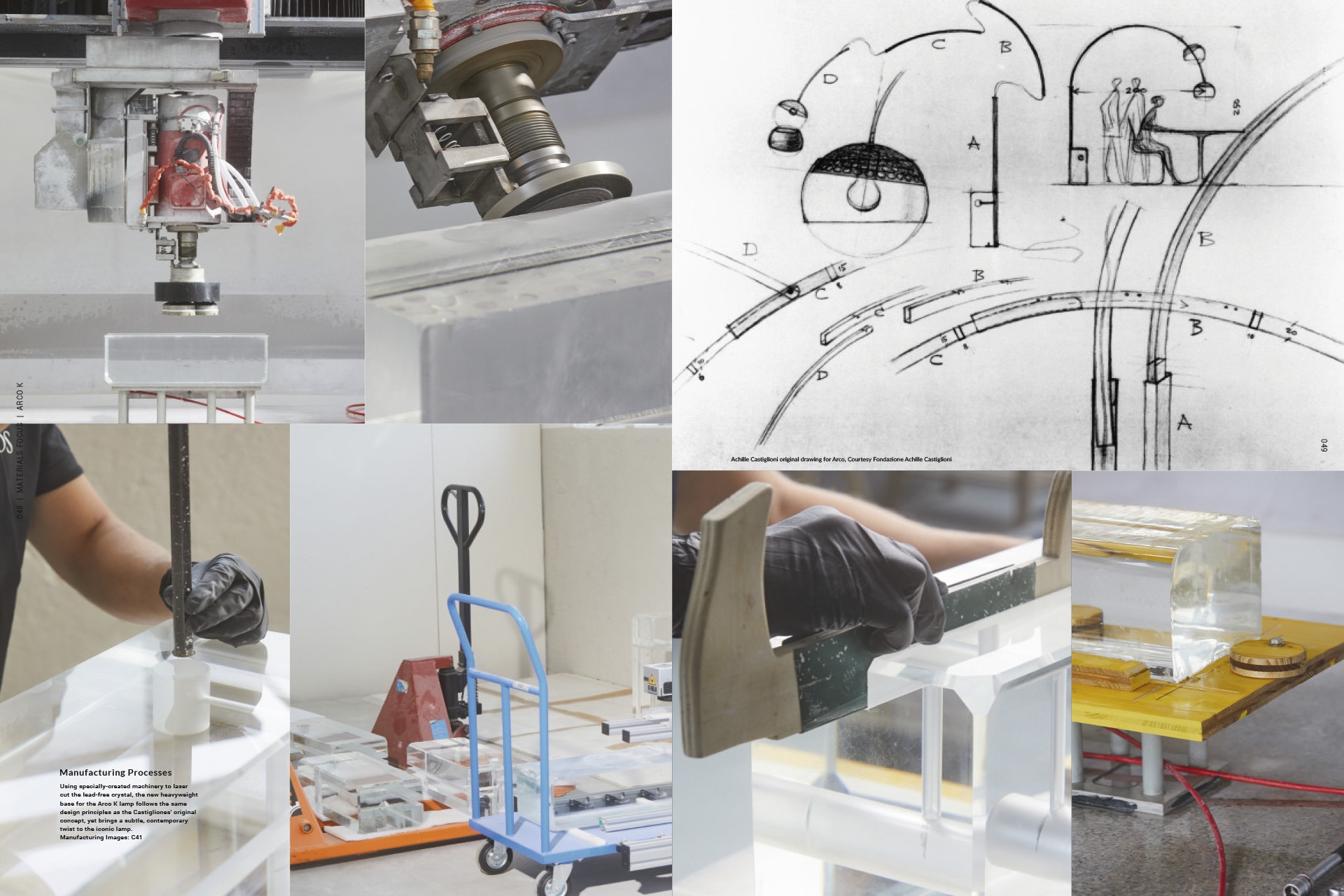
“Over time, the marble of the lamp base has been associated with an idea of preciousness and luxury that the designers did not actually have in mind: marble was indeed selected due to its heaviness and sturdiness and its capacity to withstand the metal arch and cap. At the time, it was the easiest material to find and the most logical to use,” explains Flos.
“The new choice fell on a material and a procedure that would not have been possible 60 years ago: a special lead-free crystal, which, thanks to its transparency, reveals the mechanics of the lamp and explains its operation and principle.
“The material is recyclable, heavy, refined and technical at the same time: a lead-free crystal, commonly used for optical prisms in labs, laser generators, and small gadgets that require 3D lasers inside engraving,” continues Flos. “The challenge was to move from this small scale [machinery] to a large one, while still maintaining the same high precision in the delivery.
“The high precision of the shape that was created makes the piece difficult to replicate by plagiarists because it requires a long working process.
“A spiral spring has been added around the fixing pin to ensure that the internal glass is protected from accidental scratches. And finally, the lower part of the block rests on a black mat, invisible to the naked eye thanks to the play of reflections created in the K9 crystal block.
“A floor lamp that illuminates a dining table like a chandelier, Arco is a crossover between traditional types. It is an object that symbolises expressive freedom in interiors, in line with the social and cultural revolution that was taking place in the years when it was designed.”
The Arco K is being released in a limited number of 2022 lamps, available online via pre-booking due to the nature of time it takes to create each lamp. Flos has also developed a particular encrypted NFC traceability system, which guarantees collectors the originality and uniqueness of each item number.
“While observing street lamps, Achille and Pier Giacomo began to consider how the shape of the arch made it possible to transport light from above onto objects. And then to imagine a lamp capable of accomplishing this task by freeing itself from the fixed ceiling fixture”, explain design curators Calvi and Brambilla. "Arco is a gesture, a space that provides a light that drops on things with kindness and that originates from a block that can be freely transported: in essence these were the great revolutions that this lamp brought to the history of design.”
Velvet, UK
David Collins Studio worked with appointed lighting designers dpa lighting consultants to revamp Corinthia London’s bar, now known as Velvet, into a decadent destination in the heart of London.
Velvet is a new bar that replaces Bassoon at Corinthia London, UK. The bar was reimagined by interior design firm David Collins Studio, transforming the space into a luxurious venue gowned in rich velvets and new artwork by Robson Stannard, which was curated by Creative Director of David Collins Studio, Simon Rawlings.
dpa lighting consultants collaborated closely with David Collins Studio and the hotel to develop a new lighting scheme for the hospitality venue. The aim was to highlight new features as well as upgrade existing fixtures. The team successfully re-lamped all lighting, beam angles were reconsidered, re-aimed and scene-set to create focus and drama throughout the bar. A new stage area is dressed with Par Can theatre-style lighting, creating a focus area and drawing guests into an atmosphere of opulence from the roaring twenties.
Stephanie Harris, Associate at dpa lighting consultants, says of the team’s involvement in the project: “dpa has a previous history collaborating with both Corinthia London and David Collins Studio after being appointed by the hotel to work on the design for Kerridges Bar and Grill in 2018, among other projects. So, dpa was delighted with the opportunity to join this prestigious team again on the refurbishment of Bassoon Bar – now known as Velvet. dpa was first commissioned on the project in early 2022 with the doors reopening on 1 November 2022, approximately nine months from start to finish.
“The brief for the lighting was minimal intervention due to the fast-paced project, utilising the existing lighting, upgrading existing fixtures through re-lamping, and changing beam angles to aid in enhancing the interventions proposed by David Collins Studio.”
David Collins Studio returned to the project via invitation from Corinthia’s General Manager Thomas Kochs, after originally designing Bassoon bar back in 2011.
“The brief was clear from the beginning, and we made sure to keep the strong narrative all the way from implementation through to completion,” explains Rawlings. “Our new design was respectful of the existing interior architecture while creating a distinctly bold and new guest experience that the client was so seduced by.”
Lighting played a key role in creating the dramatic and luxurious atmosphere the brief demanded. “Key decorative lighting considerations ensured the aesthetics of luminaires were in line with the roaring 1920s feel that the David Collins Studio interiors were oozing,” says Harris. “The addition of new shades with fringing and rewiring to all the existing table and floor lights transformed the fixtures to look completely different. As with all projects, dpa has a strong consideration for the circular economy and reusing, refurbishing, and rewiring where possible.
“The addition of candles to each table along with added decorative elements throughout provides that seductive intimate atmosphere that complements the magic and theatre of the bar.”
A vintage chandelier was also sourced by David Collins Studio to animate the back area and “give it a more inviting, inhabited feel”. This piece was selected for its style, adding to the overall theme of the space.
“Decorative lighting played a big role in our redesign of the space,” continues Rawlings. “As a night-time venue with no natural light, decorative lighting was key to creating the desired vision for the bar as an intimate and exclusive space. The decorative lighting provided key opportunities to update the interiors and emulate a chic late-night cocktail bar atmosphere, highlighting the opulent textiles and adding a layer of sparkle, reflecting off the new material palette.
“The existing architectural lighting was refocused, rebalanced and in certain instances repositioned to work best with the new design intent. Some of the existing decorative lighting was removed to reduce the lighting levels and create the desired ambience.
“Part of the brief was to keep the existing ceiling architectural lighting and inbuilt banquette floor lighting. We updated these with new custom shades and installed a statement vintage chandelier. Movable candle-lit lamps and glass hurricanes sit on every surface, providing an easy way to inject light and create intimacy outside of structural constraints.”
Harris adds: “The decorative lighting and architectural lighting have very different purposes on a project like this. The decorative lighting is there to provide style and visual purpose, it really enhances and complements the 1920s ambience of the interiors. This combination with subtle architectural lighting enhancing elements such as the impressive new artwork by Robson Stannard, the back bar, the stage, and the rich drapery.
“While the purpose of each is very different, the combination complements the space and provides the backdrop to enable renowned bartender Salvatore Calabrese to provide the theatre and drama through his carefully curated cocktail menu.
“As Velvet is purely a night-time venue, it differed from a lot of the projects we work on where we need to consider the daytime view of the space,” she continues. “This enabled us to fully concentrate on the sumptuous, moody atmosphere that can be felt as soon as you step into the room. The interior styling, atmospheric light levels and candlelight provide a very dramatic venue. The aspiration was always to be the destination bar in London, and we feel this is successfully achieved.”
Turning the project around in such a short time positively forced the design direction and execution of this project. The teams relied on their well-established network of suppliers in order to complete the fit-out in time. Rawlings summarises: “As the hotel remained open during the refurbishment, there was a time pressure to get the project complete. We are used to working to tight deadlines and working for an existing client like Corinthia and in London makes it easier! We have excellent suppliers and manufacturers who know how we work and that is a huge help. Efficient communication and close collaboration with consultants and suppliers made the project possible in such a short time.
“For me, Velvet captures the essence of a mood. It’s about a feeling, the discreet excitement through the pleasure of music and cocktails. Velvet embodies a bygone era. It captures the spirit of intimacy, extravagance, and secluded indulgence. Gentle lighting and twinkling surfaces exude quality and informal glamour. Strong, iconic, nostalgic, and charming. A bar like no other in London; a palette carefully curated to contrast and harmonise with dramatic swooshes of colour adorning the walls, and pattern, reflection, and depth throughout. A Velvet backdrop to the ultimate cocktails, true personal service, and the celebrated Corinthia attention to detail.”
Iain Watson, Chief Executive Officer at David Collins Studio, says in agreement: “We are delighted to return to work with the Corinthia team and create the jewel-like Velvet bar in London that adds to our timeless signature bar portfolio. The project celebrates the Studio’s passion for the blending of periods and layering of materials to redefine modern elegance.”
Harris concludes on the lighting team’s success: “We are absolutely delighted with the finished result. Normally, on most projects, we can always find something we would consider doing differently but we are so pleased with the end result and wouldn’t change anything.”
Images: Alex Upton Photography
Goddard Littlefair
Launched in 2012, London and Porto-based luxury interior design studio Goddard Littlefair celebrates its 10-year anniversary. Sitting down with darc editor Sarah Cullen, Founders Martin Goddard and Jo Littlefair discuss the studio’s successes, personal inspirations and advice for budding designers.
Goddard Littlefair has worked on numerous standout projects over the last decade, with some particular highlights including Mondrian Shoreditch in London, Gleneagles Hotel in Scotland, Mandarin Oriental Vienna in Austria, and Villa Copenhagen in Denmark.
“Where did 10 years go?” says Littlefair. “I guess starting any business, you don’t know what the future holds but you have ambitions and hopes. I think we’ve been incredibly lucky, but we’ve also worked really hard, and we’ve been a part of some amazing designs. We couldn’t have imagined what projects were going to come through our door, but they have given us opportunities and helped with our profile. You really can’t anticipate things like that.”
Goddard adds: “I think when you initially set up, you think it should work. We’ve both got a lot of experience in the industry, and we’ve worked for many years for other people. You make a lot of contacts throughout your career, and you think “ok it should work”. It’s really rewarding when connections turn around and say, “yeah ok, we’re really happy to work with you”. A few people that backed us, in the beginning, have continued backing us all the way through, and that has been really rewarding. It’s been so nice to work with the same groups, clients, and operators for many years, and that’s a testament to really good relations - and we’re just nice people,” Goddard laughs.
Setting the scene for us, the pair describe their initial conversations that resulted in the opening of the studio. “Martin contacted me on LinkedIn. We originally met and worked together in 2005 and then went our separate ways. I set up a business on my own and then had two children. Martin had gone to Canada and studied landscape design before returning to London.
Then basically, opportunities arose... Martin reached out, we started talking and hosting meetings all in restaurants and pubs, as we didn’t have an office; it was very much just on the hoof in London. I encouraged you, you encouraged me, and we just figured out it really worked, and so we thought “let’s just do this”. It all felt very natural.
“The partnership between myself and Martin is a bond that was ignited by a mutual understanding. We discovered we both spoke the same design language and that kind of connection is a very powerful one. We are both drawn naturally to different materiality, styles and colours and when you are able to learn from one another and combine the two things together, then the original idea blossoms into more than you ever envisaged in the first instance.”
“It was very much an organic progression from what we were doing,” agrees Goddard. “We would roll up to do client presentations in a taxi with a bag full of fabrics, samples, and a few sketches, and it ended up being a bit of a double act - waving our hands together at the end of the table in front of clients and they seemed to like it! As Jo’s said, it all felt very natural. And from that, we started building some really great people around us. Then, we got our first little office in Barbican, London; a tiny space in a loft above another design practice, but it was really sweet. It was our little space (only about seven of us could cram in there), but it was ours and it was all very exciting. We were both a bit like “Woah, ok what are we actually doing?”. Then we started landing some substantial jobs. You walk into a meeting when it’s the kick-off of a big project with lots of consultants, and you’re sitting there saying [shyly] “hello”. It was such a nice feeling. There was lots of hard work there but a natural progression.”
Despite their mutual love of and approach to design, the two designers had very different journeys and influences in their early lives before finding their feet in the industry.
“I was brought up in a council flat in East London,” explains Goddard. “There was not much design influence around me there. My grandfather was a cabinet maker, but that’s the only design-related part of my family. I found my own path through art. Through the process of going to an Art Foundation college [Middlesex], I gradually gravitated towards design, and interior design more specifically. So, I followed that track and went down the interiors and interior architecture route.”
In contrast, Littlefair was raised surrounded by the countryside. “I grew up on a farm surrounded by nature and very influenced by colour and the environment. I think I have some artists in my ancestry but nothing in my immediate family. My mother and grandmother were both very creative in terms of things they made that were useful, from cookery to creating garments and knitting. They were always working on things and reading. I was always into anything that was three-dimensional and tactile. That’s how I got into art; it was a hobby as well as something that I studied at school. I was completely driven by my own desire to do it. There were also a lot of family antiques in the farmhouse, which still make me feel at home even to this day.”
Goddard adds: “But I also think we both had a passion for travelling, exploring new things, and going to new places, and I think that is our reference library; our travelling experiences and seeing new places, architecture and cultures, etc. I think that’s where we’ve drawn a lot of our influences from, from our younger life and onwards even now. We love to soak up new places, which all filters down into our design work.”
“Travel has been a lifelong passion; Martin and I are both inquisitive and enchanted by different parts of the world,” says Littlefair. “Hotels are the window that tend to frame a lot of our experiences of destinations. For us, it’s extremely important to ensure that hotels enhance and elevate an experience by both meeting the needs of weary travellers and allowing them an avenue into the heart of the place. We are lucky enough to work across several sectors of interior design, but hotel design gives an element of escapism and scale that is addictive.”
As a destination that left a strong impression, Littlefair references France as a standout for her. “Paris was the first European city I went to, and I just couldn’t believe it - it was mind-blowing. It might be a bit of an obvious choice, but it’s a pretty special place.
“My parents took me to Versaille as well, which is quite random to take a teenage girl to (and my brother who was really not interested), but for me, the impression really lingered. The proportions, scale, grandeur, craftsmanship, the sense of patina, all those things were hugely impactful.”
For Goddard, it’s a little harder to narrow down: “London gives me a lot of inspiration, but I know it’s a bit of a boring answer. I love wandering around its streets, seeing things, looking up at the architecture, streetscapes, and the contrasts. There’s a lovely street where our new office is, it’s a very narrow Victorian street with old warehouses. When you look up at these Victorian buildings, there’s a modern office block and behind that is the Barbican Centre, all in one shot. It’s such a nice melting pot of how all the architecture goes together. I think it’s amazing, but any city in Europe has something special. There’s some beautiful architecture in Budapest, as well as in our favourite city Porto where our other office is, which is a cultural mishmash of Portugal and its lovely architecture. There isn’t a particular one for me, they all leave a mark on you.”
Since the studio’s infancy with a team of seven, the pair have now expanded their office in both numbers and locations. Littlefair elaborates: “It’s been quite organic and in response to the work that has come our way. You grow person by person, certainly in the very early stages. It’s a response to fulfilling that need at that time, and we’re now at a point where we have around 60 people here in London, which I have moments of “[gasp] really?!”. But I think that’s a really good number for us to be able to know each of those people, understand their skill sets and build relationships. That’s something Martin and I really like to do. We’re fundamentally designers, not just managing directors; we want to be involved with the clients, with the project managers, and the teams, and we like to know what’s going on, what the issues and challenges are, and so on. To be able to work with our team and ensure we put the right people on the right project is really vital.”
“And, we’ve got about 20 people in Porto now, which has grown in the last three years,” adds Goddard. “I think we’ve brought people in where we’ve seen we need skillsets. We’ve brought people in with great food and beverage experience because we wanted to make sure we were strong in that area. We have Epicurean, which is a little sub-brand of ours, which we use on those types of projects. We also wanted to bring in people that specialise in spas. I’m very passionate about spa design and wanted a team that has that knowledge, touch, and understanding to put that together.
“We also wanted some architectural capability as it’s particularly important for refurbishments and conversions of old buildings; sometimes you need a bit more of an interior sensibility on those structures, so architecturally it’s so good to have that asset in the team as well.
“Jo’s also a textiles designer, so I wanted more from that industry to come into our world and bring new ideas. We also have a chap from fine art; he has a lovely eye for detail. He did a lot of research into fine art but has fallen in love with interiors, and again he comes at it from a different angle.
“But we also want to bring in people with the right personality as well, someone we enjoy working with, and we want people to stay with us,” says Goddard. “We’ve had a couple of people that have joined us without a huge amount of experience, but we’ve really liked them so have invited them to stay and seen how it worked out, which has all turned out very positively.”
When asked about whether they would consider adding a lighting specialist to the team, Goddard references the highly skilled work of the lighting designers they collaborate with on projects. “If you look at our work, we do a lot with decorative lighting, because we love layering light; it’s not all just architectural. It’s all different levels of light from floor lamps to table lamps to wall lights, to chandeliers, which all create those layers of warm light. We also use a lot of bespoke lighting, which is sometimes sculptural, to create real moments for people to react to; they can be really important elements in a project.
“Lighting design can of course add that element of drama. We have a selection of designers we work closely with as consultants who are all much better at their speciality with knowledge of the technicalities and specifications etc. We collaborate closely to design a detailed brief that explains as much as possible about how we want a wall to be lit, for example, or where we need a pool of light or a focus on an important surface, or a moment we need to capture. The lighting designers are also much more skilled at putting the architectural layer on top of the decorative one.”
“I think [the importance and appreciation of the role of lighting and a lighting designer] has definitely increased over the years! It’s a really key ingredient that I think a lot of owners, investors, developers, and project managers all respect. As designers, we obviously knew the value very early on; if you get the ambience and atmosphere right, you can make a success of a space. Getting people to understand the importance of that as an investment piece as well has changed over the years; everyone now stresses that lighting is super important. So, for us it’s tabled very early on in our processes. We really think of the scenes we’re creating with lighting from a very early stage.”
Goddard expands on the importance of being aware of how lighting changes throughout the day as well, particularly referencing the flexibility of a hospitality space. “It’s not just a bar in the corner and the restaurant in another room, nowadays these spaces have broken down a lot more. That ambience that you would get in an F&B space now comes out into a lobby and other spaces. Environmentally, lighting designs are also key. We do a lot of work in resorts where we have to do dark sky lighting because of the effects on BREAM, etc. So, the value of good lighting, design, environment, energy saving, and all that other fun stuff that needs to happen, is very much front and centre.”
The topic then turned to discuss cyclical sustainable design and designing for longevity. “I just think design sensibly with respect for your things that can age, and age gracefully, and questioning whether you need to throw everything out every time you do a refurbishment. That can be interpreted as a sustainable way of treating design, but it’s something that we’ve just always considered. It’s just putting your sensible head on,” explains Littlefair.
“For the last 30 years, there has been a change in the amount that we need to be talking about sustainability, and from our perspective, we’ve always had it quite high on our list anyway, it’s just something that we’re personally very interested in. I think one of the things in design that is underestimated is the way that we approach it in terms of a sustainable and pragmatic way to what is already in existence, allowing space for things with patina, and appreciating how things age. Do they gel with the architecture already in the location and how much do you have to change for the sake of change? How much can be retained but improved? How do you design around things to make it all fit, or can you reuse and repurpose materiality, which has been been in place for a very long time? It goes hand in hand as well with cost savings. And cost savings have never been something that’s out of fashion; it’s always in fashion. In terms of a trend, it actually sits alongside sustainability quite naturally. We’ve always been driven to design cautiously, and carefully when we can but obviously if it needs to be a bigger bolder statement, we have to do that for the good of the project.”
Goddard elaborated more specifically on lighting, reflecting on the evolution of product availability over the last 30 years. Referencing fluorescence in particular, Goddard remembers the introduction of dimmable functions and colour temperature variations. These then developed into low-voltage and more energy-efficient versions before the later introduction of LEDs. It was at this point that a lot of designers became “very excited” with the possibilities available to “use these very small light sources”. “For us, it opened things up by allowing us to put lights into joinery, for example,” he says. “And when talking about lighting design, I think since the introduction of LED, it has gone leaps and bounds ahead of where it was in terms of the opportunities, and things we can now do with the lighting effects, such as wall washing. I think yes, environmentally, it is important, but I think the design opportunities given to us as the technology evolves is also actually amazing.”
Picking up on the sustainable and conscious design points, Littlefair notes that these are areas where classification in the interior design industry could be improved. “I feel that in terms of this sustainability angle, we’re often asked for a lot of thought leadership on this, which is great, but I think from our perspective, it’s understanding how to quantify what we put into projects. For example, how do we quantify in terms of the location of a manufacturer of an item to put into a project, and what does that give you in terms of co2 emissions? What is the reality of that product being recyclable? Do you get a certain point score from that sort of element of the product? Does every product that you put into a project have a score that then leads you to an ultimate qualification for the product? How well has the project done in being sustainable overall? At the minute, it’s very open; we try the best we can. And that is absolutely something we’re doing on a daily basis. But what is the long term? We’ve got rug tests for fabric, variability and durability, we’ve got fire standards, we’ve got soil and stain treatment, repellences, and things like that, but what else? What can we do on sustainability therefore to give it a score, that is easy to understand for designers internationally so that we know that we can design with some assurance?”
Goddard interjects: “We’re now seeing some finances linked to sustainability credentials too, so the developers are starting to need to demonstrate they are walking the walk as well as talking to talk about sustainability. Clients also need this information so they can go back to their investors and claim “yes, we are absolutely ticking these boxes”.
“I think the sort of system that Jo is describing would be an amazing way to report back, because it’s very difficult at the moment on traditional terms, for example with BREEAM and similar organisations, with regards to their tick boxes. They are fine but they’re not always location-specific, but are always product specific. With regards to how we qualify/judge the sustainability status of a project, at the moment we have broad brush measures but we could be more granular.
“We need to link it not only to sustainability but also our duty of care to things like modern slavery - where the product is being made, and how people are being treated. All of this stuff is really important to talk about as it could be part of this scoring system as well.”
Littlefair reinforces her point that the system needs to be in “an international language,” and “something that we can all understand and not complicate”. “We need to work together on this. We have talked to organisations about what can be done in the future. At the moment it’s all a bit of big-picture thinking.”
“And I think that pushes suppliers to make sure they’re compliant,” adds Goddard.
Another area within the industry the pair believe could use some development in is education. “Suppliers need to get into universities,” explains Goddard. “We never had a supplier come into my university to talk to us. Very rarely you might get taken out to a furniture show.
“But education from the industry back into education is really important. I think any course that gives you a year out in the industry is gold dust. That is my advice. Anyone looking at doing a degree in interior design, or any design, have a year out in the industry. I think you learn tonnes and then you come back to your last year very well connected.
“I think we need to encourage suppliers and manufacturers to establish connections with universities. So that part of the coursework is actually literal and it’s reciprocal. Chances are, a student who has suddenly been exposed to a timber floor manufacturer, for example, will specify a timber floor in their first project. I think you could also double up on those sustainability credentials and get that into that conversation.
“Education just needs to focus on what the end product is. It’s not killing creativity, but understanding how commercial environments work, and how you need to produce things. I was lucky to do a year out in my degree in my third year, and I came into my fourth year with so many more tools to use in my project work, not just changing my creativity, but how I presented it, what went on to the page, and how I thought, but also producing it in a speed that matches commercially.”
Bringing the discussion back to the studio’s success, the pair remark on some of their most notable projects, including respected wellness residential projects such as Southbank Place and the Chelsea Barracks Spa, and in hotels such as Four Seasons Hotel Istanbul at Sultanahmet and Corinthia Palace Malta.
“Over the last 10 years we’ve seen the conversations around wellness change from talking about it as being an added bonus, time and budget permitting, and confined to a designated area of an overall space, to now being an element that should be integrated into every part of an interior as much as possible,” says Littlefair. “As designers of interior spaces, no longer simply confined to the spa, we need to articulate a response that delivers on an aesthetic level and beyond, creating an environment to alter moods and assist rejuvenation.
“Getting the commission to work on Gleneagles in 2015 and working with Ennismore was amazing,” she continues. “The property is incredible; the resorts are incredible. I was really able to put the heart back into that property.
“All of the principal projects that we worked on with Starwood Capital were part of those defining moments, in our early years when the business transformed. And then you’ve got people working with the likes of Hilton, Corinthia, Berkeley Homes, Canary Wharf… And now we’ve got to the final third of our decade, working with Four Seasons and Mandarin Oriental, and really being able to breathe some life into them and go on a journey, and learning about craftsmanship in a different country. Every project is a learning curve; it still is, and always will be. You’ve got to be open to that at all points. And so, we look forward to the future. We’ve done a lot with this decade, and we’re still on that journey; who knows what the future holds?”
Looking at what’s next for the studio and what the teams are working on, Littlefair was quick to not say anything for fear of jinxing it! Goddard on the other hand is eager to broaden the studio’s geographical reach further to the States, Middle East and Europe. “The more we can do in Europe, the better,” he remarks. “I’d also like a landmark project in London. I’d like to do a real standout. We’ve got some lovely projects in the city already, but I mean a real standout property would be amazing to do as it always ticks the box for us.”
To finish off, in addition to Goddard’s advice on taking a year in the industry to experience the commercial world during your training and education, the final pieces of advice from the pair include being humble and finding your specialism. “I did textile design; I had no idea that there was a whole career you could do in interior design,” explains Littlefair. “I was way behind Martin in that respect. I thought interior design was for the exclusive echelons of the uber-rich, and it is to a degree, but when you go into hospitality design, there’s a whole world where you can get really involved and actually make interiors for everybody to share, which is really lovely. That’s why we love hospitality design - the theatre of it. I suffered from a lack of experience and understanding of what jobs there were out there, and I think jobs are constantly being created and there are different roles that we hear about all the time. It’s not as straightforward as it used to be. Within interiors there are specialisms. So just go for what you really enjoy, do what you really love doing, practice and hone it, and do as much of it as you can to soak it all up.”
Goddard concludes with one of the pieces of advice he received when first starting out, “be humble”.
“Appreciate the people around you who have got more experience, more talent. They’re doing their job because they’ve worked hard to do it. It’s not going to be given to you on a plate, you have to learn. As a designer you need to get the experience, you need to follow a project all the way through from start to finish. You need to hone your skills and communication with clients and with your colleagues. There’s so much to learn and you have to grow as a person; it takes time. Hospitality projects may take two years, three years, or five years depending on the size of the new build or refurbishment. You need to have the patience to learn and be open to learning from the people around you. And if you’re lucky to have really good people you work with and they take you under their wing, appreciate that. Appreciate that they’re taking time out from themselves to teach you. Get your head down, work hard, and learn.”
“And be a nice person!” exclaims Littlefair.

